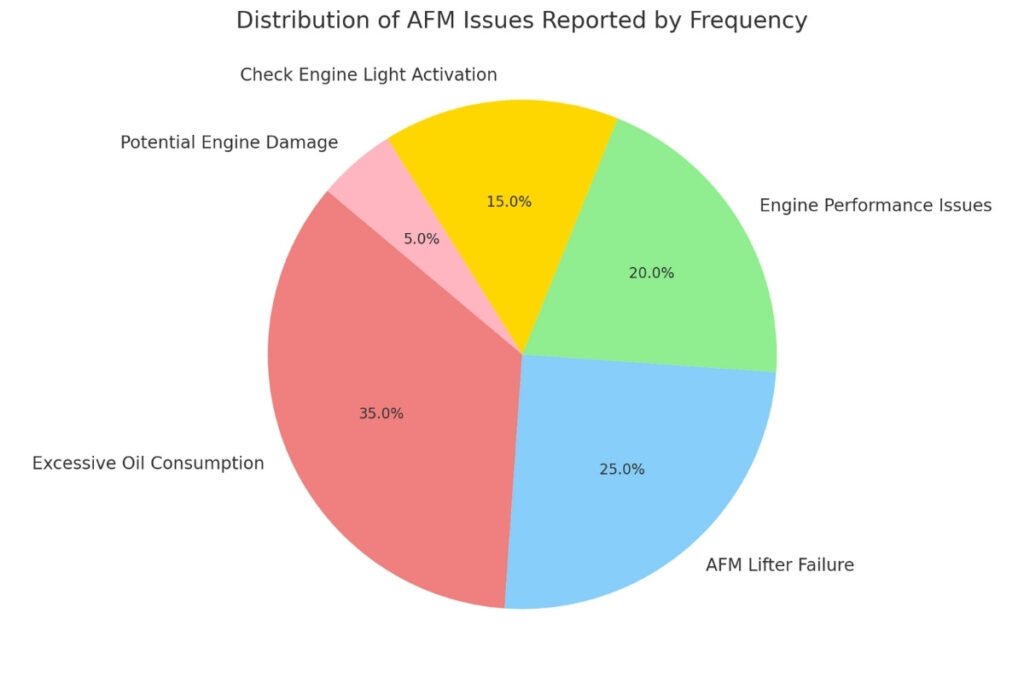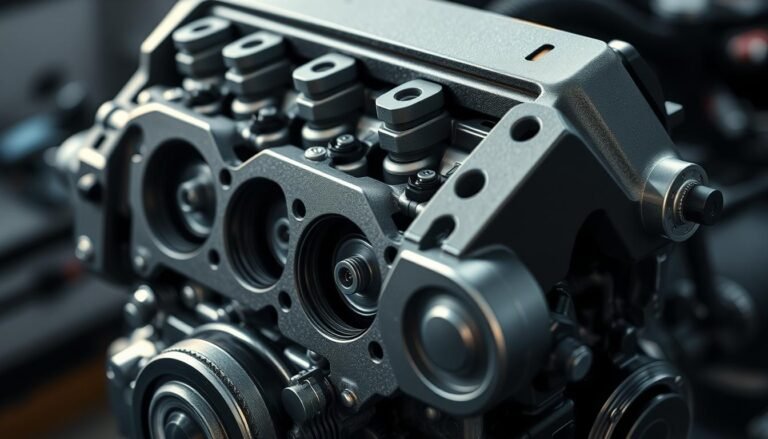GM Vehicles AFM Disabler Problems and Troubleshooting
AFM disabler problems are common among GM vehicle owners who have these devices installed in their vehicles to trick the Active Fuel Management system into not shutting down engine cylinders to save fuel.
As for AFM disablers, although they can ensure the engine will be full-powered and run consistently, they often come with plenty of drawbacks. These include illuminating the check engine light, increasing load on the engine with the possibility of overheating, draining of the battery, and malfunctioning performance-like slow throttle response.
Being in a position to understand such potential problems will definitely be important for a car owner to assess whether the use of an AFM disabler is in line with their vehicle’s priorities for performance and maintenance.

What Is an AFM Disabler?
An AFM disabler is an Active Fuel Management system deactivation device in an electronic nature. The AFM system, otherwise known as Dynamic Fuel Management or DFM for some brands.
These are also being put to wide usage in specific General Motors or GM engines, such as the models V8 and V6.
Under light load conditions, it will automatically disable half of the cylinders of the engine. In turn, this technology contributes to improving fuel economy by saving fuel during low-power driving.
However, despite the fact that AFM improves fuel economy, there are a number of reasons some drivers seek ways of switching this system off. They include:
Performance Consistency:
The on-goings of an AFM system exhibit noticeable shifts in power delivery, hence the inconsistency in performance.
An AFM disabler, however, maintains all cylinders active at all times and smoothes out the drive.
Preventing Engine Wear:
Some owners claim that the constant cycling between active and deactivated cylinders could cause uneven wear patterns, and perhaps eventual mechanical failure, down the line.
Deactivating AFM keeps the operation uniform across all cylinders, supposedly helping with longevity.
Smoother Sound of the Exhaust:
AFM changes the pitch of your car’s exhaust the moment it decides to shut down some cylinders. An AFM disabler keeps the engine running smoothly and constantly, retaining a throaty sound in the exhaust, which is pleasing to the ears of any automobile enthusiast.
The AFM disabler will be plugged into most vehicles on the OBD-II and shut the function down completely of the AFM system. The result of this is that it keeps all cylinders in the engine constantly firing, which means there is no need to go through the process of turning on and off.
The given unit is quite easy to install and simple to use; nevertheless, drivers should be aware of possible concerns, such as battery drain or even incompatibility with some vehicle models.

What Does an AFM Disabler Do?
An AFM Disabler is an electronic device designed to disable Active Fuel Management systems in vehicles. Active Fuel Management-also called Dynamic Fuel Management for some brands-is technology used to improve fuel economy by shutting down half of the cylinders in an engine under light load conditions.
Here’s what an AFM Disabler does:
Function of an AFM Disabler:
Keeps All Cylinders On:
The AFM Disabler forces the AFM system to leave all cylinders on all the time. This defeats the action of the engine that would otherwise be constantly switching between full power (V8 mode) and the most economic mode (V4 mode).
Smoothes Engine Operation:
The AFM Disabler does this by keeping all the cylinders engaged, hence preventing those harsh transitions and vibrations when the engines switch modes. This way, it provides a more linear and predictable drive.
Improves Power Delivery:
Since all cylinders are fired, this opens up the full power capability of the engine, which comes in very useful during instances of towing, hauling heavy loads, or even performance driving. This ensures that power delivery is not only constant but also reliable.
Plug-and-Play Installation:
Most AFM Disablers are designed to install easily, by simply being plugged into the vehicle’s OBD-II port. They are thus also super user-friendly and reversible; they can quickly be turned on or off, as one would need them.
Can AFM Disabler Cause Problems?
The AFM disabler can cause certain problems, even though many drivers use them without big issues.
That system is designed to aid fuel efficiency and shuts off certain engine cylinders when full power isn’t needed, which happens while highway cruising or other low-load conditions. Operating on fewer cylinders, cars can consume less fuel and thus improve their overall fuel economy.
However, while this technology has an eco-friendly purpose, some drivers prefer another approach as far as their driving experience is concerned. This is where the AFM disabler intervenes.
Despite these advantages, there are times when using an AFM disabler brings about its own share of challenges.
AFM Disabler Problems
The use of the AFM Disabler provides for smoother engine performance and better power delivery in cases where the transition between cylinder modes is disruptive.
It is not a perfect world, however, and there can be some potential issues with disabling Active Fuel Management. While this may sound nice for a plug-and-play solution, there are some significant problems it may cause to your vehicle’s performance, longevity, and overall efficiency.
The following are some of the major problems with the use of an AFM Disabler:
1. Battery Drain Issues
General complaints associated with these AFM disablers relate to excessive battery draw. Most of these units attach to the OBD-II port and can remain on even after the vehicle has been shut off.
This, of course, may lead to a dead battery if one doesn’t drive often, or if the device doesn’t have an auto-power-down feature.
2. Compatibility Concerns
It does mean that not all the vehicle disablers are compatible with every make or model. The compatibility problems sometimes take a turn for the worse, as the failure of a disabler working incompatibly with the engine management of any particular vehicle can trigger warning lights on the dashboard or result in irregular performance.
Make sure that the device you buy should be for your model to evade these types of problems.
3. Warranty Voids
Using an AFM disabler may void your vehicle’s warranty. Many manufacturers treat such devices as modifications that affect the normal and usual operation of the engine management system.
Such will lead to the possible voiding of warranty coverage, which may be expensive in replacing power train components if something happens.
4. Anomalies to the Working of the Engine
Some AFM disabler users complained about issues with their engine, such as rough idling, misfiring, and/or uneven power delivery. These imperfections almost always arise as a result of the incorrect installation or tampering of the vehicle ECU.
Using a good device and installation by professionals diminishes any chances of these risks, although they can never be ruled out completely.
5. Software Glitches and Device Failures
Like any electronic device, the AFM disablers can suffer from software malfunction or fail altogether. Issues are common if the firmware is outdated, bugs in the software, or an overall faulty device.
Frequent updating of the device’s software and selecting a good brand is the strategies that could offset this shortcoming.
6. Poor Fuel Economy
Since the major role of AFM is to improve fuel economy by shutting off some cylinders when they are not needed, disabling the system will definitely reduce fuel efficiency.
For those drivers who care less about saving on fuel and prefer performance, this may be a reasonable trade-off, but nonetheless one that one must consider before using an AFM disabler.
7. Check Engine Light Activation
This is how an AFM disabler can trigger the check engine light; it means the computer system of the vehicle shows disturbances or something wrong with the normal working.
But because this is not the case in serious problems, every warning light needs to be diagnosed on time to make sure there are no other possible causes hiding under its light.
| Problem | Frequency Reported (%) | Severity (1-5) |
|---|---|---|
| Check Engine Light Activation | 30 | 4 |
| Increased Engine Stress/Overheating | 25 | 5 |
| Battery Drainage | 15 | 3 |
| Engine Performance Issues | 20 | 4 |
| Emissions Test Failure | 5 | 2 |
| Potential Warranty Implications | 10 | 3 |
Range Technology AFM Disabler Problems
The Range Technology AFM Disablers work to disable Active Fuel Management that may be installed in your GM vehicle and keep all cylinders active for smoother and steadier engine performance.
While these kinds of devices improve driving experiences, there are also certain problems that could arise from their use. Numerous problems are associated with Range Technology AFM Disablers, here are five of the most common:
Most Common Range Technology AFM Disabler Problems
Check Engine Light Activation:
Users have often complained that the check engine light just stays on after they installed the Range Technology AFM Disabler, beeping into the actual status of the vehicle’s engine management system.
Smaller Fuel Economy:
The continuous activity of all the cylinders would amount to increased fuel consumption and affect the overall rating of fuel economy that your car gets.
Dead Battery Issues:
The device may remain powered even when your car is off. This could mean a dead battery for those who drive their cars less frequently.
Compatibility Issues:
These Range Technology AFM Disablers are not all universally compatible with each different vehicle model. If it doesn’t fit the particular engine management of your car, the consequences could be warning lights or an inconsistent performance.
Increased Engine Wear:
Continuously firing all cylinders by a Range Technology AFM Disabler in operation might shorten the lifespan of certain components inside the engine itself, maybe asking for more frequent maintenance than usual.
How To Disable AFM On 5.3
It can offer better engine performance and smoothing out the driving by disconnecting the AFM system on a 5.3 engine. Be aware, though, that this could alter fuel economy in your vehicle and perhaps void your warranty for doing such modifications.
Consider consulting with a professional mechanic before making such modifications.
Here are the steps to disable AFM on a 5.3 engine:
Step 1. Provide access to the Engine Control Module:
Identify where the Engine Control Module is located in a vehicle, usually under the hood or near the firewall. This shall be done by disconnecting the negative battery cable so that in the process, there will not be electrical problems arising.
Access the ECM, and with the aid of the use of a tuning device or programmer which when used will alter the software inside an engine,.
Step 2. Reprogram the ECM via the following:
This is accomplished with the tuner by attaching it to the OBD-II port under the dash on the driver’s side of the vehicle. Reprogramming essentially involves following the instructions provided in the tuning device for reprogramming of the ECM, usually by selecting to disable AFM using menus on the device.
The tuning device will then upload new software into the ECM that prevents the AFM system from ever deactivating any cylinders.
Step 3. Check Changes
Once you have successfully reprogrammed the ECM, reconnect the negative battery cable and crank the engine. Check any dashboard warning lights and listen for unusual engine sounds.
Next, road-test the vehicle to confirm that the AFM system is now off and that the motor is performing well. You can also use a diagnostic tool and verify that no AFM codes are showing.
Troubleshooting AFM Disabler Problems
Troubleshooting the AFM Disabler involves problem identification and the execution of necessary steps to resolve a particular issue.
The most common problems and their respective troubleshooting tips are discussed below.
Check Engine Light On:
Problem: The check engine light does not turn off after the installation of the AFM Disabler.
Solution: Connect with a diagnostic tool, read out the error codes, and then clear any AFM-related codes. Ensure the device has been installed correctly and is compatible with your vehicle.
Bad Fuel Economy:
Problem: The fuel economy gets worse after the installation of an AFM Disabler.
Solution: Keep track of your fuel consumption and compare it with previous consumption. If you find it significantly lower, use the AFM Disabler only when required or take advice from a professional mechanic.
Battery Discharge Problems:
Problem: The AFM Disabler kills the battery when the vehicle is off.
Solution: Check that the device has some form of automatic power-down feature. If it does not, you may want to look for one that does or simply disconnect the AFM Disabler when the vehicle is not in use.
Compatibility Issues:
Problem: The AFM Disabler does not actuate as expected on your vehicle.
Solution: Compatibility with the particular model of your car: please, contact the manufacturer about compatibility and perform easy installation according to the given instruction.
Increased Wear of an Engine:
The problem: The engine suffers from accelerated wear.
Solution: Regularly check the work of the engine and perform maintenance according to the schedule. Use AFM Disabler not often to decrease loads on the parts of an engine.
FAQs
Can an AFM Disabler Cause Engine Damage?
Even though AFM disablers keep all engine cylinders running, a possible consequence of its installation and use is engine malfunction. Compatibility with your vehicle and adhering to the use instructions given by the maker minimize this possibility.
Will using an AFM Disabler Void My Vehicle’s Warranty?
Installing an AFM disabler may be considered tampering with or modification of the original system installed in your vehicle. This may affect warranty coverage, so you will want to contact your vehicle’s manufacturer or check with a dealership for their stance on warranty prior to installing the product.
Are AFM Disablers Compatible with All Vehicles?
Not all vehicle makes and models allow for AFM disablers. For appropriateness, one needs to ensure that the disabler one intends to use is meant for that particular vehicle to avoid potential problems.
What Are the Signs of an AFM Disabler Malfunction?
The common indicators that the AFM disabler is working improperly include a check engine light coming on, the idling running a little rough, or simply the power delivery becoming non-linear-or the AFM system refusing to be disabled as expected.
A good number of these can be minimized with continuous checks on the device’s connection and updating of the software.
Does an AFM Disabler Affect Emissions?
Yes, using an AFM disabler would affect the emissions since this keeps the all-cylinder active. This may lead to more fuel consumption and possibly higher emissions that could affect compliance with environmental laws in certain regions.
Is It Safe to Use an AFM Disabler Long-Term?
While many users report a host of trouble-free long-term uses of AFM disablers, the prolonged use is not without its own set of problems, ranging from increased wear to engine components to a drain in the battery. Normally, it is advisable to carry out periodic maintenance and monitoring for safety during long-term use.
Can AFM Disablers Cause Interference to Other Vehicle Systems?
In that respect, AFM disablers can interfere with other electronic systems in the vehicle when fitted, sometimes causing various dashboard warning lights or system errors. Ensuring it is installed and updated correctly can minimize these risks.







